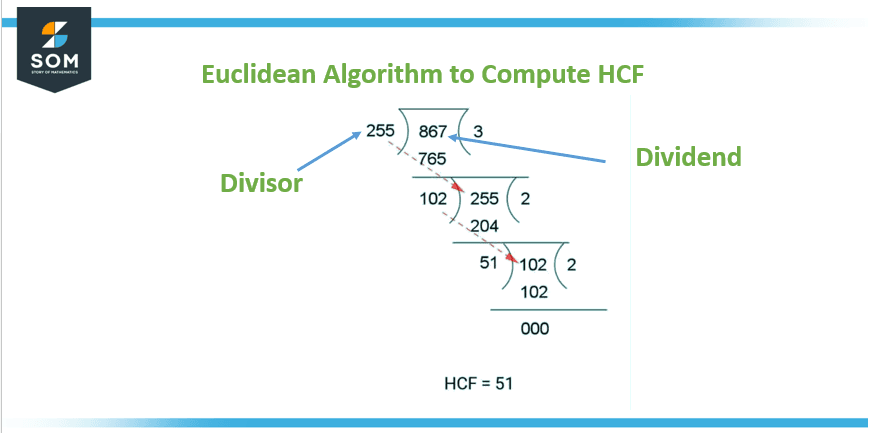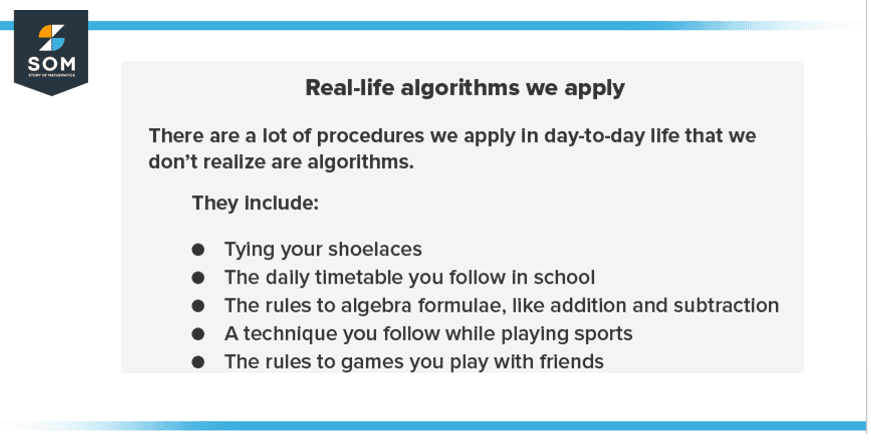JUMP TO TOPIC
Algorithm|Definition & Meaning
Definition
An algorithm is a well-defined sequence of steps focused on solving a particular problem. It is like a recipe, except the dish you are cooking is a mathematical one. Long division is one algorithm to find the quotient of any division operation. It even has branching steps dealing with all the situations that you see! Computers function completely on man-made algorithms.
An algorithm is a series of guidelines or procedures that are carried out in a certain sequence in order to solve a problem or achieve a goal. It is a detailed process for finishing a particular activity or problem.
Algorithms are used in computer programming and mathematics, as well as in many other fields, such as operations research and artificial intelligence. The concept of the algorithm is depicted in Figure 1 below:

Figure 1: Concept of algorithm
An algorithm can be easy or complicated, and it can be stated in a variety of ways, including as natural language, pseudo code, or code written in a specific programming language.
Algorithms in Mathematics
In mathematics, an algorithm refers to a set of well-defined instructions for performing a specific task or solving a specific problem. These instructions can be in the form of a formula, a set of steps, or a procedure.
Algorithms are used to help solve mathematical problems, such as finding the greatest common divisor of two numbers or solving a system of equations.
The Euclidean algorithm, used in mathematics to determine the greatest common divisor (GCD) of two numbers, is an illustration of an algorithm. The algorithm is as follows:
- Take two numbers, a and b.
- Divide a by b and get the remainder, r.
- If r is zero, then b is the GCD.
- If r is not zero, then repeat steps using b and r.
The GCD of two integers is equivalent to the GCD of the smaller number, and the remainder after the bigger number is divided by, the smaller number, according to the Euclidean algorithm. By using this algorithm repeatedly, the GCD of two numbers can be found efficiently.
One such example of computing HCF using the Euclidean algorithm is shown below in Figure 2.

Figure 2: Euclidean Algorithm
Historical Background
The concept of algorithms has been around for centuries, dating back to ancient times. The earliest known algorithm is the Euclidean algorithm, which was described by the Greek mathematician Euclid around 300 BCE. This algorithm is used to find the greatest common divisor (GCD) of two numbers and is still in use today.
Al-Khwarizmi, an Arab mathematician, authored “The Compendious Book on Calculation by Completion and Balancing” during the Middle Ages, which introduced the concept of algorithms for solving mathematical problems.
The word “algorithm” is derived from the Latinized version of his name, Algoritmi. During the Renaissance, the concept of algorithms was further developed by mathematicians such as Fibonacci, who introduced the Fibonacci sequence and the algorithm for finding it.
Algorithms were also used in the design of mechanical calculators and other devices. In the 19th century, Charles Babbage designed the Analytical Engine, which was considered to be the first general-purpose computer. Babbage’s design included a concept of algorithms, which were used to control the operation of the machine.
The invention of electronic computers in the 20th century greatly increased the use of algorithms. Algorithms were used to solve a wide range of problems, from simple calculations to complex scientific and engineering problems. The field of computer science was established, and the study of algorithms became an important part of it.
The concept of algorithms also became crucial in the field of artificial intelligence, as it is used to develop efficient and effective solutions for problems such as speech recognition, image analysis, and natural language processing.
Overall, the history of algorithms is a long one, and it is deeply rooted in mathematics, computer science, and other fields; It will continue to be a key idea in resolving issues and bettering our world because it is evolving and playing a significant part in many facets of our life.
Advantages of Algorithms
Algorithms have many advantages; some of the most notable include the following:
Efficiency
Algorithms are designed to be efficient in terms of time and space complexity, meaning they can solve problems quickly and use minimal resources.
Repeatability
Algorithms can be repeated multiple times to produce the same result, making them reliable and consistent.
Automation
Algorithms can be implemented as computer programs, which can perform tasks automatically and without human intervention.
Optimization
Algorithms can be used to optimize a solution to a problem by finding the best possible solution among a set of alternatives.
Scalability
Algorithms can be designed to handle large input sets and scale up to accommodate more data or increased complexity.
Generalization
Algorithms can be designed to be general and apply to a wide range of problem instances rather than being specific to a single problem.
Flexibility
Algorithms can be modified or combined to solve different types of problems or to improve performance.
Verification
Algorithms can be verified for their correctness, and their performance can be analyzed and improved.
Algorithms play a vital role in many aspects of our lives, from simple calculations to complex scientific and engineering problems. They are fundamental to the functioning of computers and other digital devices, and they are employed in numerous industries, including finance, healthcare, transportation, and a host of others.
Properties of Algorithms
Algorithms have several properties that are important to consider when designing or analyzing them. Some of these properties include:
Input
Algorithms take input in the form of one or more data sets, which can be in various forms, such as numbers, strings, or other data structures.
Output
Algorithms produce output, which can be in the form of a single value, a set of values, or a more complex data structure.
Definiteness
Algorithms have a clear set of instructions that are well-defined and unambiguous.
Finiteness
Algorithms terminate after a finite number of steps, meaning they will always produce an output.
Feasibility
Algorithms can be executed by a computer or other machine, meaning they are physically possible to implement.
Generality
Despite being exclusive to a single problem, algorithms can be used to solve many other types of problems.
Effectiveness
Algorithms should be able to produce the correct output for any input within the specified range.
Complexity
Algorithms can be analyzed in terms of time and space complexity, which measures the number of resources required to execute the algorithm.
Optimality
Algorithms can be designed to find the optimal solution amid a range of options or to identify a nearly perfect answer.
Clarity and Simplicity
Algorithms should be easy to understand and implement, so they should be clear and simple as possible.
It’s important to note that an algorithm can have different properties and trade-offs, and choosing the right algorithm for a particular problem depends on the desired properties. Algorithm design and analysis is a complex field, and the properties of algorithms are subject to continuous research and development.
Algorithms in the Real World
Some of the real-world applications of the concept of the algorithm are shown in Figure 3 below:

Figure 3: Real-life applications of the algorithm
Algorithms are used in many different fields and industries, and they have a wide range of applications in the real world. Some examples of algorithms in the real world include:
Search Engines
Algorithms are used to determine the relevance and ranking of web pages when a user performs a search.
Social Media
Algorithms are used to determine which posts and content will be shown to users in their news feeds.
Recommendation Systems
Algorithms are used to make personalized recommendations for products, music, movies, and other content.
Image and Speech Recognition
Algorithms are used to analyze and interpret images and speech, which are used in applications such as self-driving cars, facial recognition, and voice-controlled assistants.
Data Compression
Algorithms are used to reduce the size of data files, making them more efficient to store and transmit.
Cryptography
Algorithms are used to secure communications by encrypting and decrypting messages.
Financial Trading
Recommendations and decisions about the purchase and sale of stocks, currencies, commodities, and other financial derivatives are made using algorithms.
Healthcare
Algorithms are used to analyze patient data and make treatment recommendations, as well as to identify potential outbreaks of infectious diseases.
Transportation
Algorithms are used to optimize routes for delivery trucks and other vehicles, as well as to manage traffic flow in cities.
Robotics
Algorithms are used to control the behavior of robots and drones, enabling them to navigate, manipulate objects and make decisions.
These are only a few instances of the numerous applications of algorithms in the real world. Algorithms continue to play an increasingly important role in our daily lives, and their applications will continue to expand in the future.
Example of Creating an Algorithm
Create an algorithm to evaluate if an integer is odd or even.
Solution
The algorithm to determine whether an integer is odd or even is:
Step 1: We divide the integer by 2.
Step 2: The integer is even if it can be divided evenly by 2; otherwise, it is odd.
All images/mathematical drawings were created with GeoGebra.
